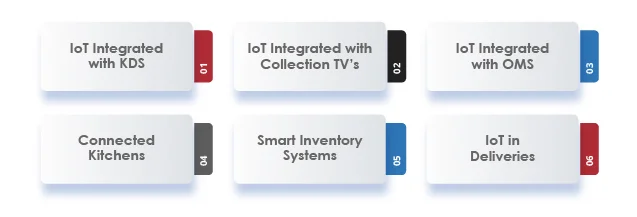- IoT in QSRs: The Connected Ecosystem
- Challenges in IoT-Driven QSR Operations
- Testing Connected Kitchens
- Testing Delivery Systems
- Test on real-devices
- Key QA Strategies for IoT in QSRs
- Automation in IoT QA: Enhancing Efficiency and Accuracy
- How TestingXperts Can Transform IoT QA in QSRs
- Conclusion
Imagine this: A bustling Quick-Service Restaurant (QSR) during peak hours. Orders overflow via mobile apps, kiosks, and drive-thrus. The connected kitchen devices get in sync to prepare meals, and IoT-enabled delivery systems ensure timely dispatch. But what if an order is delayed or is not correct due to the poorly functioning device or application? In an environment where 72% of QSR customers prioritize accuracy and speed, such minor disruptions in IoT systems can lead to dissatisfied customers and loss of revenue.
To keep pace with the evolving customer needs and technology, QSRs need to ensure their IoT systems function seamlessly. This is where rigorous Quality Assurance (QA) for IoT comes into play. Let’s dive deep into the role of QA in maintaining operational excellence in QSRs.
IoT in QSRs: The Connected Ecosystem
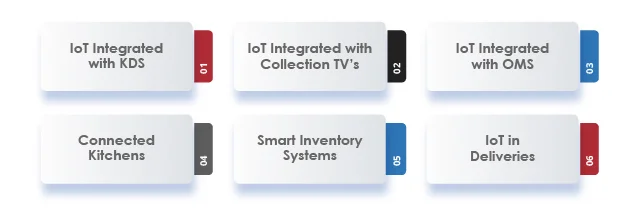
The integration of IoT in QSRs has transformed operations. From automated flyers to GPS-enabled delivery bikes, IoT simplifies and accelerates the processes. In addition to this, it harnesses phonic sensors with KDS (Kitchen Screens), OMS & Collection TV’s. For instance:
IoT Integrated with KDS – Detects new orders received on Kitchen Display Screens real time to ensure timely food preparations.
IoT Integrated with Collection TV’s – Ensures timely pickup and the collection of prepared food.
IoT Integrated with OMS – Helps keep a check on real-time order updates.
Connected Kitchens – Devices like smart ovens and refrigerators that optimize energy use and ensure food safety.
Smart Inventory Systems – Real-time tracking in order to prevent wastage or stockouts.
IoT in Deliveries – GPS tracking, route optimization, and automated dispatch to ensure timely delivery.
However, such reliance on interconnected devices requires thorough testing to avoid system breakdowns.
Challenges in IoT-Driven QSR Operations
While IoT offers multiple advantages, it comes with its unique set of challenges:

Interconnectivity and Communication Gaps
QSR make use of devices from multiple vendors, each with its protocols. Ensuring these devices communicate is a critical way to prevent breakdowns in operations.
Data Security and Privacy Risks
IoT systems in QSRs process sensitive customer data, from payment information to personal addresses. A security lapse may result in financial and reputational damage.
Scalability Across Locations
For QSR chains across the globe, ensuring IoT solutions work in uniformity across thousands of locations is a dauting thing. Variability in network infrastructure and device configurations adds to the complexity.
Testing Connected Kitchens
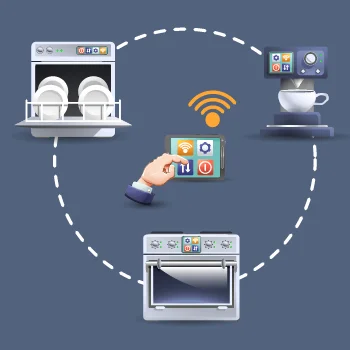
Testing connected kitchens is critical for maintaining perfection and efficiency in IoT-driven QSR environments. Validating kitchen automation systems ensures that automated appliances, like ovens, smart fryers, beverage dispensers, KDS, Order Management Systems, Printers, etc. operate flawlessly under diverse conditions.
QA rigorously tests for scenarios like sudden power fluctuations or high-order volumes, checking that automation systems maintain consistency in food preparation. Ensuring synchronization between devices is also important to guarantee that orders are executed on time. For example, the coordination between a smart grill and an order management system needs to align preparation and serving times to avoid delays. The Robust QA testing enhances operational efficiency and also ensures a high-quality dining experience for customers.
Testing Delivery Systems

The delivery experience in the quick industry can make or break customer satisfaction. With the IoT-enabled delivery systems, ensuring that every order reaches its destination accurately and efficiently is crucial. Quality Assurance (QA) plays a key role in testing and validating these connected delivery systems, ensuring integration and operation at every stage of the journey.
1. Testing GPS and Real-Time Tracking Features
Real-time tracking is the foundation of modern delivery systems, offering customers visibility into their order’s journey. QA assures the accuracy of GPS systems, validate tracking updates, and verifies that location data is in sync across the devices, ensuring customers are always in the loop.
2. Evaluating Delivery Time Predictions and Route Optimizations
IoT systems in QSRs often include AI-driven time prediction algorithms and route optimization. QA evaluates these features to ensure the exact delivery time estimates and efficient routing. This enhances customer trust, optimizes fuel consumption and delivery logistics.
3. QA for Integrating Third-Party Delivery Platforms
QSRs often are dependent on third-party platforms to expand their delivery reach. They ensure these integrations work flawlessly, validate order processing, payment systems, and real-time updates to lessen the errors and delays, creating a consistent customer experience.
Through rigorous QA practices, delivery systems in QSRs become efficient, reliable, and customer-centric, changing the last-mile experience into a competitive advantage.
Key QA Strategies for IoT in QSRs
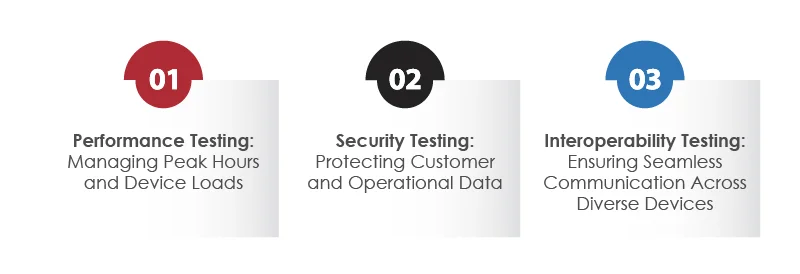
Effective QA strategies are crucial for harnessing the complete potential of IoT in the QSR industry. By addressing unique challenges, QA makes sure that IoT systems operate securely, smoothly, and efficiently.
Performance Testing: Managing Peak Hours and Device Loads
IoT systems in QSRs shall handle high traffic during peak hours without any compromise on speed and accuracy. Performance testing ensures that systems and devices maintain optimal functionality under heavy loads, protecting both operational efficiency and customer satisfaction.
Security Testing: Protecting Customer and Operational Data
With IoT systems collecting huge amounts of sensitive data, security is paramount. QA employs rigorous security testing to identify vulnerabilities, ensuring that operational data and customer information remain safe against breaches and unauthorized access.
Interoperability Testing: Ensuring Seamless Communication Across Diverse Devices
QSR ecosystems involve a wide range of IoT devices, from start fryers to delivery trackers. QA pays attention to interoperability testing in order to verify that these devices interact effectively, developing synchronized operations and preventing disruptions caused by incompatible systems.
By implementing these targeted QA strategies, QSRs can leverage IoT to create secure, robust, and scalable solutions, ensuring streamlines operations and exceptional customer experience.
Automation in IoT QA: Enhancing Efficiency and Accuracy
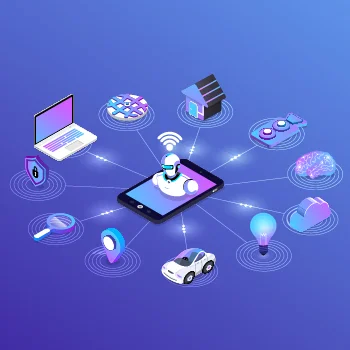
Automation plays a crucial role in optimizing IoT QA processes, ensuring both accuracy and efficiency. With the increasing complexity of IoT systems, manual testing only is not sufficient. Automation streamlines repetitive tasks like performance and security testing, permitting faster detection of issues and reducing human errors. Automated testing tools can simulate real-time scenarios across various devices, ensuring that whole IoT ecosystem functions seamlessly. This accelerates the testing cycle and also enhances perfection of results, enabling QSRs to meet the demanding operational standards and deliver exceptional customer experience.
How TestingXperts Can Transform IoT QA in QSRs

Tx brings unparalleled expertise and innovation to the table, ensuring that IoT-driven systems in the QSR industry are tested with the highest standards of quality assurance. With a deep understanding of both the complexities of IoT ecosystems and the operational needs of QSRs, Tx offers comprehensive IoT testing Solutions ensuring seamless device integration, system performance, and customer satisfaction. By employing advanced testing automation tools and methodologies, like AWS IoT, and Azure IoT hub, Tx delivers scalable and reliable IoT solutions, helping QSRs meet the demands of the modern QSR system.
Summary
The integration of IoT systems into connected kitchens and delivery processes is transforming how businesses operate and serve customers. Quality Assurance plays a crucial role in ensuring these systems function smoothly, delivering consistent and reliable performance across all touchpoints. From testing automation systems in kitchen to validating delivery routes, effective QA is the key to maximizing operational efficiency, driving business growth, and enhancing customer experience. With its deep expertise and proven track record in IoT testing for QSRs, Tx is uniquely positioned to support QSRs in optimizing their IoT-driven ecosystems. As QSRs continue to embrace digital transformation, partnering with Tx ensures that their IoT systems are robust, scalable, secure, and enables them to stay ahead of the curve in the competitive industry.
FAQ
Q1. How is IoT Testing used in the QSRs industry?
IoT Testing in QSRs ensures the seamless integration and functionality of connected devices, such as smart kitchen appliances, POS systems, and delivery trackers, to enhance operational efficiency and customer experience.
Q2.. How do we test connected kitchens in QSRs?
Connected kitchens in QSRs are tested through end-to-end functional, performance, and interoperability testing of IoT devices to ensure they communicate efficiently, maintain data accuracy, and support real-time monitoring.
Q3. How does TestingXperts support IoT QA in QSRs?
TestingXperts provides comprehensive IoT QA services for QSRs, leveraging advanced automation tools to validate device connectivity, data security, and system performance, ensuring smooth kitchen and delivery operations.
Q4. How can performance testing help QSRs during peak hours?
Performance testing helps QSRs simulate high-demand scenarios to ensure systems like POS and delivery trackers remain responsive, reducing downtime and maintaining customer satisfaction during peak hours.
The post IoT Testing in QSRs: Ensuring Quality in Connected Kitchens and Deliveries first appeared on TestingXperts.
Source: Read More
